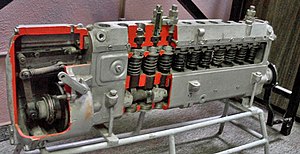Injection pump
This article relies largely or entirely on a single source. (February 2019) |

An injection pump is the device that pumps fuel into the cylinders of a
Safety
Because of the need for
Construction

Earlier diesel pumps used an in-line layout with a series of cam-operated injection cylinders in a line, rather like a miniature inline engine. The pistons have a constant stroke volume, and injection volume (i.e., throttling) is controlled by rotating the cylinders against a cut-off port that aligns with a

For use on cars and light trucks, the rotary pump or distributor pump was developed. It uses a single injection cylinder driven from an axial cam plate, which injects into the individual fuel lines via a rotary distribution valve. Later incarnations such as the

All injection pumps incorporate a governor to cut fuel supply if the crankshaft rpm endangers the engine - the heavy moving parts of diesel engines do not tolerate overspeeding well, and catastrophic damage can occur if they are over-revved. Poorly maintained and worn engines can consume their lubrication oil through worn out crankcase ventilation systems and 'run away', causing increasing engine speed until the engine destroys itself. This is because most diesel engines only regulate their speed by fuel supply control and most don't have a throttle valve to control air intake, other than those with EGR systems.
New types
Mechanical pumps are gradually being phased out in order to comply with international emissions directives, and to increase performance and economy. From the 1990s an intermediate stage between full electronic control were pumps that used electronic control units to control some of the functions of the rotary pump but were still mechanically timed and powered by the engine. The first generation four and five cylinder VW/Audi TDI engines pioneered these pumps before switching to
See also
Injection pressures during the whole process should be above 1000–1200 bar for a good spray formation and air–fuel mixture; a tendency in practice to 1600–1800 bar and higher is noted.
